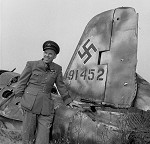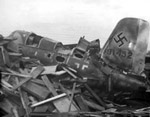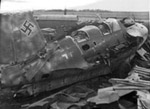
|

|
191452 is a very obscure Komet: except for the photos below, nothing is known of its history. Ransom & Cammann Volume 2 don't mention this aircraft in Chapter 16 ('Where are they now') which deals with all captured examples. Appendix 5, page 429 has 191452 (as part of the batch 191442-453) listed as 'No information available'. Probably the only reference to 191452 can be found in Phil Butler's 'War Prizes'. In the entry for AM204, WNr 191454, the aircraft is mentioned as a probable mistaken identity:
Coded 'Yellow 11' of JG400. Surrendered at Husum and shipped to the RAE. Despatched from Farnborough to No. 6 MU, Brize Norton, on 12th July 1945 and used as a static exhibit in Hyde Park, London, during September 1945. Later returned to No.6 MU, being recorded there at the Census on 21st March 1946. On 25th June 1946, transferred to No. 47 MU, Sealand, for packing and transfer to Canada. AM 204 left Salford Docks on 28th August 1946, aboard the SS Manchester Commerce and arrived at Montreal on 9th September. One of the record cards for this aircraft has been interpreted as reading 191452, but photographic and other documentary evidence supports the view that 191454 is the correct identity. This aircraft is believed to have been scrapped at Arnprior, Ontorio, in about 1957.
Stephen Fochuk kindly provided the following unique photos that have never before been published. They were made at the aircraft dump at RCAF Station Arnprior, Ontario, in September 1957. Stephen reports that the RCAF Officer in the picture is 'Skeets' Ogilvie of No.609 RAF Squadron and The Great Escape fame, and parts of Battle of Britain veteran Bf 109E WNr 1190 can be seen. The fuselage is in the background (behind the Komet's tail), resting on its right side, and the wings are in the foreground. This 'Emil' was coded 'White 4' and belonged to 4/JG26. Flown by Horst Perez, it belly-landed on 30 September 1940 at Beachy Head. The aircraft went to Farnborough, and later to the USA and Canada. In 1968 it returned to Britain and a restoration was started. It is now on display at the Imperial War Museum at Duxford. Les Butler has a profile of this aircraft.

|

|
The photos show an interesting camouflage variation: the front and center fuselage is painted solidly, yet the rear fuselage and vertical tail are mottled. Like the Australian Komet, the fasteners on the lower fuselage are all painted over, presumably in red. Both photos show a peculiar detail on the leading edge of the tail: it looks like some sort of wooden strip is attached there. The aircraft appears to have been stripped or vandalised quite extensively, with the nose cone, canopy, armor glass, tail root fairing and various hatches missing, and the gun bay is empty. But it must be said that the 12-13 year old paint job held very well!
Demonstrating how obscure this Komet is, the next photos turned up 17 years later. They were found online by Kevin Kibbe. They are in low resolution unfortunately, blown up to 800 pixels. But we can see the right side for the first time! Location is presumably still the RCAF Station Arnprior dump.

|

|